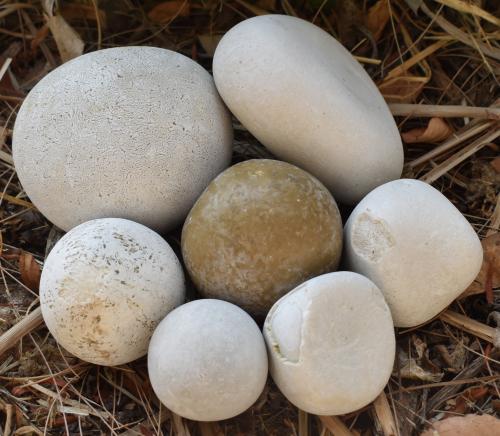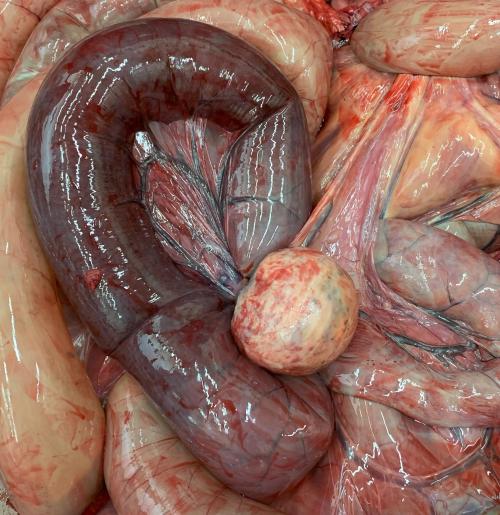Colic: A Pain in the Gut
Colic is a top concern for owners and veterinarians. Although it is common, our understanding of colic is complicated by the fact that it is not a simple disease, but a syndrome of clinical signs that encompasses multiple risk factors.
Abdominal pain in horses ranges from mild and easy to treat (or resolves on its own) to severe and requiring surgery, generally falling into one of four categories.
General Types of Colic
Intestinal dysfunction - This type of colic usually responds to medical management and has a good prognosis. It includes:
- Gas colic - Buildup of gas in the intestinal tract causes abdominal pain as the gas stretches the intestines. Causes include dietary changes, lack of roughage, and intestinal parasites.
- Spasmodic colic - Abnormal contraction of the intestines due to buildup of gas or other causes can create painful spasms.
- Simple impactions - Impactions occur when feed, sand, etc. lodge in the colon, making it difficult for the horse to pass manure.
Intestinal obstruction - Blockages can cause severe pain and often require surgery. These can be physical blockages, such as with a foreign object, or functional in which the flow of food is impaired due to lack of normal movement in the intestines. These include:

- Enteroliths - Enteroliths are mineral accumulations around a foreign object (pebble, bailing twine, etc.) that form stones inside the large colon where they
can remain until they move and cause an obstruction. Causes include certain diets, breed predisposition, and management practices. The only treatment is surgical removal. Prognosis depends on the size of the stones, their location, and when they are detected. - Displacements - The equine intestine ranges from 50 to 70 feet in length and large sections are not anchored, or are only attached by small lengths of tissue, so they can move to abnormal locations. The prognosis for horses that undergo surgery is generally good.
Intestinal strangulation - Strangulating colics result from interruption of the blood supply to the gastrointestinal tract. They are life threatening and always require surgery. These include:

- Lipomas - Lipomas are benign fatty tumors connected to the abdomen by a length of tissue. They can loop around the intestine and cut off the blood supply (“strangulating lipomas”). Lipomas are prevalent in horses over 15 years of age (but can be seen in horses as young as 8), and in breeds such as Arabians, American Quarter Horses, and ponies. Once clinical signs appear, intestinal tissue has already started dying, so identifying the problem early and getting the horse to surgery quickly improves the outcome.
- Torsion/volvulus (“twisted gut”) - Since equine intestines are so long, sections can become twisted and cut off the blood supply. The degree of torsion significantly affects the prognosis, with horses exhibiting intestinal twisting of less than 180° having a good prognosis, horses with greater than 270° torsion having a poor prognosis, and those in between having a fair prognosis.
Other Intestinal Problems
Additional causes of colic that need intensive medical treatment include:
- Enteritis/colitis (diarrhea) - Enteritis is inflammation of the gut caused by bacteria or viruses. Colitis results from inflammation of the inner lining of the colon and can have infectious or non-infectious causes.
- Peritonitis - Inflammation of the inner lining of the abdominal cavity (peritoneum) can be a primary disease, or secondary to infectious or noninfectious agents.
- Neoplasia (cancer) - Intestinal tumors in horses are rare. Some grow locally, whereas others can metastasize throughout the body. The prognosis is generally poor.
- Poisonous/toxic plants - Ingestion of plant toxins can cause colic, but horses usually need to consume high volumes of the plant to become affected.
Risk Factors for Colic
| Risk factor | Colic problem |
| >15 years of age | Strangulating small intestinal lesions |
| History of cribbing | Epiploic foramen entrapment |
| Pregnant mare or recent foaling | Large colon volvulus, uterine torsion/tear, internal hemorrhage |
| Fed >50% alfalfa or has access to sand | Enteroliths, sand colic |
| Recent medications (antibiotics/NSAIDs) | Colitis, Non-steroidal anti-inflammatory drug (NSAID) toxicity |
| Previous abdominal surgery | Adhesions |
| Recent stall confinement | Impaction colic |
Horses are predisposed to colic due to their unique gastrointestinal anatomy, but risk factors are known. Some can be modified, but even the most well managed horses can colic.
Not Modifiable
- Breed - Some breeds may be at higher risk for certain types of colic.
- Age - Certain age groups may be more prone to particular types of colic.
- Height - Large horses may be at risk of dorsal displacement of the large colon; small colon impaction is often reported in ponies.
- Weather - Weather changes may affect movement and water consumption.
Modifiable
- Exercise and Housing - Provide turnout, maximize water intake, and maintain a routine schedule.
- Feeding - Feed small amounts at frequent intervals, choose alternatives to concentrated feeds, make any feed changes slowly, and minimize feeding errors.
- Health management - Ensure routine veterinary care (including deworming and dental care).
Other risk factors
- Cribbing/windsucking - Stereotypies have been significantly associated with colic.
- Travel - Changes in management and stress due to travel can result in decreased gastrointestinal mobility, which can cause colic.
